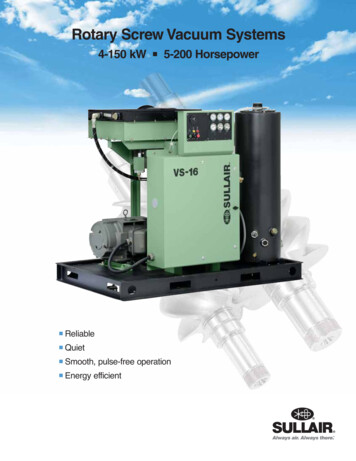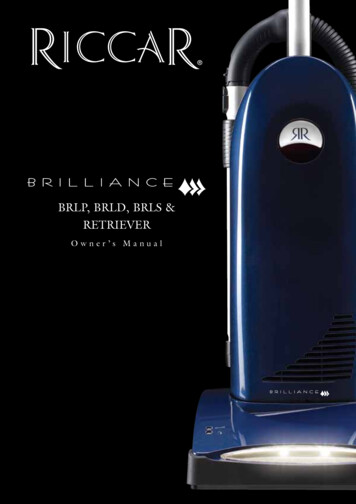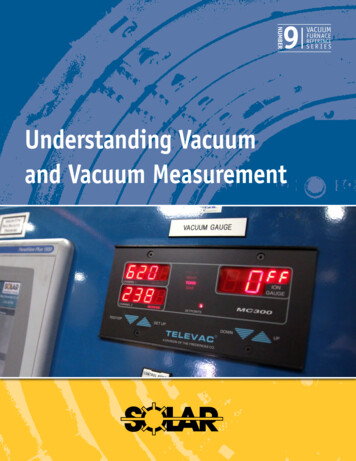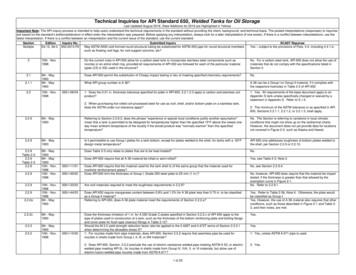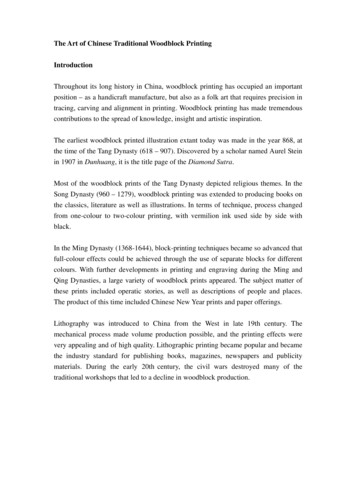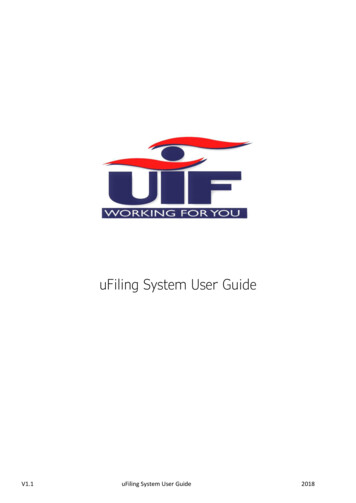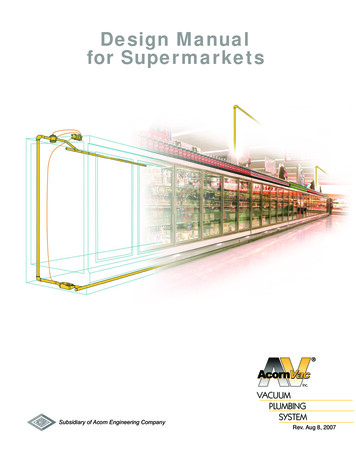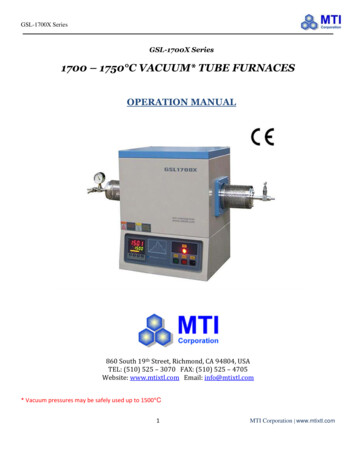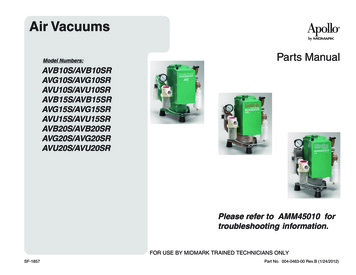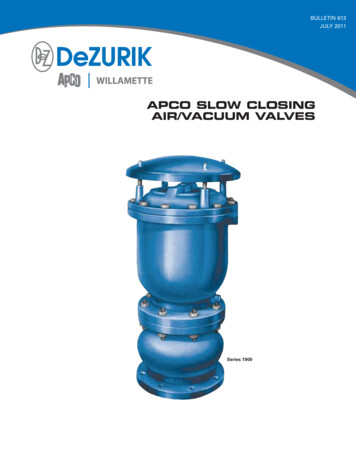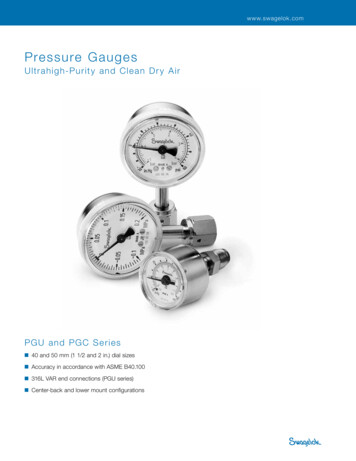
Transcription
WHITE PAPERBENEFITS OF 3D PRINTINGVACUUM FORM MOLDSAUTHORS COLE HARTMAN (MECHANICAL ENGINEER) & VERONICA DE LA ROSA (INDUSTRIAL DESIGNER)FATHOM is driven by advanced technologies.We leverage our expertise in 3D printing and additive manufacturing to help our customersinnovate faster and more efficiently.Our product portfolio includes professional 3D printers and manufacturing systems,prototyping and advanced manufacturing services, with design and engineering resourcesin support of these.We strive to be our customers’ preferred partner by providing best-in-class equipment,services, and support.
BENEFITS OF 3D PRINTINGVACUUM FORM MOLDSINTROVacuum forming is a versatile and easy to learn process. With affordable 3D printed toolingand a wide variety of applications, it could be the perfect fit for your next prototypingproject. Vacuum forming with 3D printed molds is a great way to quickly create 3D partsfrom plastic sheet material. This document outlines how to take advantage of the uniquebenefits of Stratasys 3D printers for vacuum forming applications.OVERVIEWPLASTIC MATERIALSA wide range of plastic sheet materials are compatible with the vacuum forming process.A few notable materials are: ACRYLONITRILE BUTADIENE STYRENE (ABS)ACRYLICCO-POLYESTER (PETG)POLYSTYRENE (PS)POLYCARBONATE (PC)POLYPROPYLENE (PP)POLYVINYLCHLORIDE (PVC)Benefits of 3D Printed Vacuum Form Molds F001 2014During the vacuum forming process a plastic sheet is uniformly heated until an appropriateprocessing temperature is reached. The sheet is then stretched and forced against themold’s surface by a vacuum, producing a plastic sheet formed to the shape of your mold.Each material has its own unique processing requirements, and some grades may bemore suitable than others for your project. Refer to the manufacturer’s documentation forspecific information on your material. Check your machinery capabilities and material databefore investing resources in tool design and printing.23d printer sales // rapid prototyping // design consultation // studiofathom.com // 510.281.9000 // oakland, ca & seattle, wa
3D PRINTED VACUUM FORM MOLDSFDM (Fused Deposition Modeling) is the most common technology used for creating 3Dprinted molds for vacuum forming and offers many unique benefits.FDM allows you to print in various sparse fill densities, giving the molds an inherent porositythat results in a uniform vacuum to be drawn throughout the tool. This can greatly simplifythe fabrication of the tool. In addition, FDM machines are capable of printing molds in avariety of durable, heat resistant plastics that prolong the life of the mold.Both technologies simplify the tool fabrication, allowing engineers and designers to testmultiple tooling strategies concurrently, and shortening the time to produce the first articlesof a design. Other additive manufacturing technologies can be considered.TOOL DESIGN CONSIDERATIONSDraft // Adding draft to the vertical surfaces of a part will help when removing the mold fromthe newly formed plastic part. Best practice is to use a minimum draft angle of 1 -3 anda draft angle of 5 or more — this greatly helps when releasing the tool from formed parts.Undercuts can be successfully vacuum formed in special cases depending on your partgeometry and material thickness.Webbing // Geometries with deep draws and vertical walls are usually at risk for webbingduring processing. More draft will help with webbing in these types of geometries.Shrink // Most plastic sheets shrink during the vacuum forming process. Shrinkage ratesdepend on the type of plastic used and its thickness, but usually range between 0.4% and0.8%. You can accommodate for shrinkage in the mold design.Sharp Corners // Use a minimum radius of curvature on tool features that is greater than thematerial thickness of the plastic you will be vacuum forming.Benefits of 3D Printed Vacuum Form Molds F001 2014PolyJet (UV-Cured Photopolymer Jetting) is another common technology used for 3Dprinting molds. PolyJet-based machines build parts with fine layer resolution, and as aresult, produce parts with very smooth surfaces. PolyJet vacuum form molds require littleto no post processing and are great for making molds with organic and curvy surfaces.PolyJet molds don’t share the porosity of sparse fill FDM molds, but air vents can easily bedesigned into critical areas of the mold prior to printing, eliminating the labor and potentialinconsistency of manual drilling.Venting // If molds are to be built in PolyJet, design vents to pull vacuum in female molds andin critical areas and recesses of male molds. Smaller diameter holes will be less noticeableon the surface of the formed parts, but size holes large enough that they are not too difficultto remove support from.33d printer sales // rapid prototyping // design consultation // studiofathom.com // 510.281.9000 // oakland, ca & seattle, wa
TOOL PRINTING CONSIDERATIONSFDM // Insight software available on Stratasys’ Fortus 3D production systems providesusers with a lot of control over raster densities on the interior volume of your mold. The toolpaths can even be specified to be built with air gaps throughout the entirety of the part, oryou can create custom groups if you wish to vary the porosity throughout the tool. Stratasysprinters with Catalyst software can print molds in two different sparse fill densities or solid.Tool Finishing // The plastic sheet used for vacuum forming tends to pick up the texture ofthe mold. This is especially apparent when using thin or clear plastic sheets. FDM moldswill likely need to be sanded to smooth the layer lines on the mold. Start with 120 grit sandpaper and use successively finer grits as necessary to meet the surface finish requirementsfor your application.APPLICATIONS Interior trim panels in automotive and aerospace applicationsAgricultural applications (seed trays and flower tubs)Architectural model making and furnitureLighting covers, panels, and diffusersConsumer electronics enclosures and screen bezelsMovie and drama propsMedical equipment enclosures, protective equipmentMachine guards and safety equipment in manufacturing environmentsModels making in cars, boats, and aircraftPackaging, point of purchase, signage applicationsFood, gelatin, and chocolate moldsProtective casesBenefits of 3D Printed Vacuum Form Molds F001 2014Vacuum forming, and thermoforming (pictured below), is well known for use in packagingapplications, but this versatile process has numerous application uses:43d printer sales // rapid prototyping // design consultation // studiofathom.com // 510.281.9000 // oakland, ca & seattle, wa
CASE STUDYCREOS is an internal project designed, created, andproduced by the FATHOM team in an effort to demonstratethe many uses of 3D printing and advanced prototypingtechnologies for the product development process.CREOS is a 3D printed action figure with detachable armsand legs built on the Objet500 Connex in VeroWhite,TangoBlackPlus, and VeroClear (PolyJet TechnologyMaterials). The hat is created in Nylon12 on an SLS machineand dyed yellow in post-processing. The calipers were madeon a uPrint SE Plus (FDM) in real ABS thermoplastics. All CADdevelopment was completed in-house by FATHOM’s design and engineering team.1.The design of the molds began by extruding profiles around the CREOS’ body,sneakers, and calipers at a draft angle of 3 2.The front and back extrusions of the body weretrimmed with a curved surface to accommodatesectional differences in the parts3. All knife edges were filleted and sides of thebase of the mold were drafted at 3 4. Once the CAD modeling for the mold wascomplete, each part was printed in ABS on auPrint SE Plus (this material was chosen to takeadvantage of FDM’s sparse fill)5. Since the molds were simple in geometry, lightsanding was required to attain the desiredsmoothness6. Once sanded and approved, the molds were ready for vacuum formingBenefits of 3D Printed Vacuum Form Molds F001 2014To demonstrate the many ways 3D printing can be used in an application, CREOS isencased in a PETG plastic shell that was vacuum formed using a 3D printed FDM tool.53d printer sales // rapid prototyping // design consultation // studiofathom.com // 510.281.9000 // oakland, ca & seattle, wa
uPrint SE Plus (this material was chosen to take advantage of FDM’s sparse fill) 5. Since the molds were simple in geometry, light sanding was required to attain the desired smoothness 6. Once san
